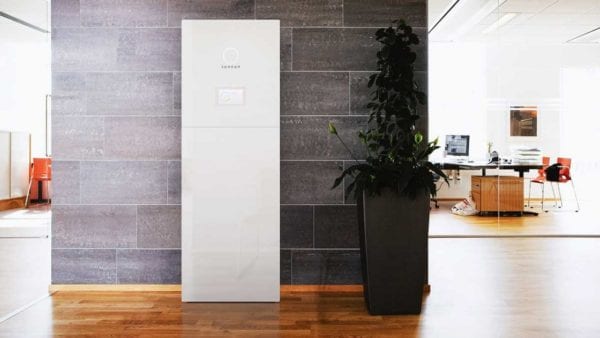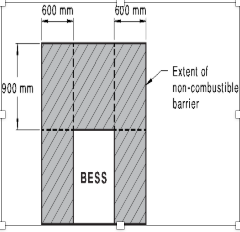Last week, Standards Australia finally published its new standard for household battery installations, including strict new rules designed to minimise fire risk.
It means, for one, that installations like this in your lounge room (above) are not possible.
But what does it really mean for an industry that is already struggling to gain traction? We try to find the answers to your questions.
Q: What is this new Australian battery installation safety standard people are talking about?
The new standard is called AS/NZ 5139 2019, and it’s Australia’s first – and many would say, well overdue – set of rules designed specifically to guide the safe installation of residential battery storage systems.
It was published by Standards Australia last week after a laborious and sometimes controversial five-year draft and consultation process.
Q: Isn’t this a good thing?
In many ways, yes. As Guy Stewart from the Rainbow Power Company explains in this helpful video, “we’ve seen the roll-out of batteries in Australia and around the world sort of ramp up in the last few years, and it is an appropriate time to have some indications and guidelines for installation.”
Q: But it’s not all good news?
No (see below).
Q: How does it change things for the installation of battery storage systems in Australian homes?
According to SolarPlus – which was co-founded by solar and battery storage tech guru Glen Morris, who is also on the SA committee for all this – the standard details seven hazard categories and more than 110 risk management factors that need to be considered when installing residential battery storage.
But there are two major changes getting most of the attention.
The standard requires CEC-accredited battery systems to be installed with additional cement sheeting or other non-combustible material where there is a habitable room on the other side – that is pretty much anything but a bathroom or laundry.
The non-combustible material needs to be placed between the wall and the battery unit and must extend 600mm to the left and right of the battery and 900mm above it.
This does not apply if the wall in question is made of brick, tiles, concrete or any other material that has been tested to be non-combustible.
The standard also means a pre-assembled integrated BESS cannot be installed within 60cm of any exit; within 60cm of any vertical side of a window, or any building ventilation opening to a habitable room; within 60cm of any hot water unit, air conditioning unit or any other appliance not associated with the pre-assembled integrated BESS; or within 90cm below any of the above items.
Further, the standard denotes that battery systems cannot be installed in ceiling spaces; wall cavities; on roofs except where specifically deemed suitable; under stairways; under access walkways; in evacuation or escape routes (such as a hallway); in areas of domestic or residential electrical installations; or in habitable rooms.
For non-accredited batteries, the rules are even tougher, and the batteries must be housed in a separate purpose-built fire-proof structure, separate from the house or garage (if the garage adjoins the house).
For installers, and particularly electricians, there are also some fairly major changes around switching from LV (low voltage) and ELV (extra low voltage) thresholds to a new internationally recognised classification called DVC, or Decisive Voltage Classification.
Basically speaking, this means a number of existing battery systems will now have to be held to higher wiring rule standards – and installers could watch Guy Stewart’s video (which was filmed before the standard was published, but still applies) to get their heads around this.
Q. Why have these changes upset some major battery manufacturers?
Major industry bodies and players including Tesla, Sonnen and LG Chem have argued – and continue to do so – that the standard is too heavy handed, particularly when many companies have taken significant measures to make their products safe to install in homes.
They say the rules will add unnecessary cost and complexity to installations, and in some cases – and in particular in light of the complicated spacing specifications – could rule out the installation of battery storage altogether for some households where there is no suitable position for a unit to be located (my own weatherboard home included).
Battery makers have also complained that the standards have been written to a “perceived” risk, and not a proven risk, and basically assume that all batteries are are the same and are, a) going to spontaneously combust, and b) sustain a fire, thus requiring measures to prevent the spread of fire.
“The concrete, what it’s there for, is because what you don’t want is for the wall to get really hot and blow something up on the other side,” Sonnen’s technical director for Australia and New Zealand, James Sturch, told One Step.
“This assumes that your system can spontaneously burst into flames, and then that the fire would be self-sustaining. But very few types of battery can do that.
“There’s no functional benefit from doing this. But they have to do it because there are no product standards.”
As LG Chem Australia’s general manager Phil Crotty notes, the two battery fires we have had in Australia both involved a cheap Chinese brand.
What this battery standard means, however, is that one of his company’s thoroughly tested and zero fire risk-rated RESU home batteries are required to employ the same level of prevention as those cheaper, less safe batteries.
“One of the key things here, is we actually think the standard is going to reduce the safety [levels for households]; it’s going to add costs to all installations, whether it has met the highest possible standards or whether it hasn’t, and put more pressure [on consumers] to go with the lower-cost batteries, which would tend to be less safe,” Crotty told One Step.
Q: How does the Australian standard compare to installation rules overseas?
The main difference, says Crotty, “is that in other markets they rely on a product standard, and a product standard makes it safe to install.”
These product standards include international standard IEC 62619 – which Standards Australia has already adopted – which in other regions, including Europe, deems batteries sufficiently safe to be installed in household attics or basements.
Batteries that meet this standard have been shown to be able to be in a fire – for up to an hour – and not catch fire or sustain the fire.
“That’s the standard we have in Australia. It’s necessary, we have that,” says Crotty.
Another international standard, UL1973, uses similar testing, but also requires battery manufacturers to induce thermal runaway (the worst case scenario) – even though many have shown this can’t naturally occur in their products – and prove that if it does, your battery won’t explode, or emit flames.
“So we actually have essentially a fireproof container,” Crotty says. “The US and EU standard are both tested to that level, across those two standards, and so don’t require this extra stuff because the product standard is good enough.”
We don’t apply the second product standard in Australia because the UL at the time didn’t have a commercial relationship with the SA body. Nevertheless, most major lithium battery manufacturers adhere to it across their brand.
According to Crotty, LG Chem has safely deployed 180,000 RESU home batteries worldwide and a further 2.7 million batteries for EVs and hybrids, which use the same chemistry.
And he adds: “The same technology going into the houses, we supply NASA space suits with their battery. We make the same product. And there’s no cement sheeting there.”
Q: Will the new rules add to the cost of installing a battery for consumers?
In many cases, yes. Various industry representatives including Sonnen have estimated that the addition of cement sheeting and the need for extra labour will add an average $1,000 of extra cost to the installation of batteries in homes. This may not seem like much, but for solar households already reluctant to shell out for a battery, it could be the deciding factor. And for an industry that is only just taking off, this amounts to a significant new speed hump to increased adoption.
Q: Is the standard applicable immediately?
Technically speaking – and according to the CEC – that AS/NZS 5139 does not become mandatory until the Wiring Rules, AS/NZS 3000 reference it or individual jurisdictions choose to amend their regulations. The Wiring Rules are currently going through an amendment process and are expected to be published sometime in the first half of 2020.
But it is, nonetheless, a published standard, and will ultimately be an enforceable standard, so the broad view is that it should now be adhered to.
As Sonnen’s James Sturch put it, “if something did go badly wrong, I wouldn’t want to be standing in front of a judge trying to explain why a battery was not installed according to the published standard.”
Sonnen, for its part, is hoping to have a final statement of direction and advice on the new standard to hand to its industry partners by the end of the month. It is hoping to get input for this from installers at the All-Energy conference next week.
Q: Would existing home battery installations require retrospective safety retrofits once the new Standards are approved, or would they be grandfathered out?
The answer to this question appears to fall into the “open to interpretation” category, that is also the basis of further criticism of the standard – too many of the guidelines are open to different interpretation.
Sturch says it’s unlikely that systems already installed will be held to the new standard, but says this may change if existing systems need replacing under warranty, or more storage is added, and so on.
Q: What does this rule mean for the li-ion batteries in electric vehicles that will increasingly be parked in the garages of Australian homes?
According to Sturch, the AS/NZ 5139 2019 standard applies to non-portable equipment only. If it’s not physically fixed to the house, or attached with permanent wiring then the standard should not apply.
Q: Is industry seeking to have some of the more “heavy-handed” rules of the standard amended?
Yes. Both the Smart Energy Council and the Clean Energy Council have indicated that they will continue to work with their members and with Glen Morris to amend some of the parts of SA/NZ 5139 they did not agree with.
CEC chief Kane Thornton said this included clause 4.2.4.2 and clause 5.2.4.2 – which set out the requirement for protection against the spread of fire and clearance around a battery installation.
The goal for everyone, Thornton stressed, was to have an effective battery installation standard that would “help limit the installation of dodgy, higher-risk batteries, ensuring consumer confidence in the safety of batteries and the industry’s continual growth.”
“What we’re planning to do,” says LG Chem’s Crotty, “is to engage with the Australian Fire Authority and try to understand why, for them, these (internationally accepted) product standards are insufficient.
“My suspicion is, when we think of the amount of … fallout there was from the home insulation debacle, everybody is very risk averse.
“We have no problem with that, but let’s assess the risk properly and make appropriate standards.
“It’s about education. They haven’t seen enough information on the nature of the testing that is done.”
Q: Where can I get further information on all this?
There is a CEC explainer video available in the member section of its website. And the Smart Energy Council is running a Smart Energy Installer Roadshow from 7-21 November 2019 with Glen Morris, from SolarQuip.
You can get your own copy of the standard via Standards Australia here, but it will cost you around $340 for a hard copy, or just over $300 for a PDF version.
To read the original version of this story on RenewEconomy sister site One Step Off The Grid, click here…











